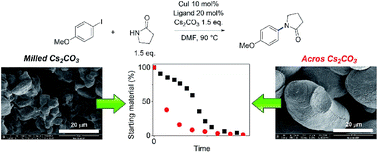当前位置:
X-MOL 学术
›
Chem. Sci.
›
论文详情
Our official English website, www.x-mol.net, welcomes your
feedback! (Note: you will need to create a separate account there.)
Origins of high catalyst loading in copper(I)-catalysed Ullmann–Goldberg C–N coupling reactions
Chemical Science ( IF 7.6 ) Pub Date : 2017-08-29 00:00:00 , DOI: 10.1039/c7sc02859h Grant J. Sherborne 1, 2, 3, 4, 5 , Sven Adomeit 6, 7, 8 , Robert Menzel 1, 2, 3, 4, 5 , Jabor Rabeah 6, 7, 8 , Angelika Brückner 6, 7, 8 , Mark R. Fielding 5, 9, 10, 11 , Charlotte E. Willans 1, 2, 3, 4, 5 , Bao N. Nguyen 1, 2, 3, 4, 5
Chemical Science ( IF 7.6 ) Pub Date : 2017-08-29 00:00:00 , DOI: 10.1039/c7sc02859h Grant J. Sherborne 1, 2, 3, 4, 5 , Sven Adomeit 6, 7, 8 , Robert Menzel 1, 2, 3, 4, 5 , Jabor Rabeah 6, 7, 8 , Angelika Brückner 6, 7, 8 , Mark R. Fielding 5, 9, 10, 11 , Charlotte E. Willans 1, 2, 3, 4, 5 , Bao N. Nguyen 1, 2, 3, 4, 5
Affiliation

|
A mechanistic investigation of Ullmann–Goldberg reactions using soluble and partially soluble bases led to the identification of various pathways for catalyst deactivation through (i) product inhibition with amine products, (ii) by-product inhibition with inorganic halide salts, and (iii) ligand exchange by soluble carboxylate bases. The reactions using partially soluble inorganic bases showed variable induction periods, which are responsible for the reproducibility issues in these reactions. Surprisingly, more finely milled Cs2CO3 resulted in a longer induction period due to the higher concentration of the deprotonated amine/amide, leading to suppressed catalytic activity. These results have significant implications on future ligand development for the Ullmann–Goldberg reaction and on the solid form of the inorganic base as an important variable with mechanistic ramifications in many catalytic reactions.
中文翻译:

铜(I)催化的Ullmann–Goldberg C–N偶联反应中高催化剂负载的起因
对使用可溶碱和部分可溶碱的Ullmann–Goldberg反应进行的机理研究,通过(i)用胺产物抑制产物,(ii)用无机卤化物盐抑制副产物和(iii)鉴定了催化剂失活的各种途径。通过可溶性羧酸盐碱进行配体交换。使用部分可溶的无机碱的反应显示出不同的诱导期,这是这些反应中可重复性问题的原因。出人意料的是,更精细地研磨了Cs 2 CO 3由于去质子化的胺/酰胺的浓度较高,导致诱导期更长,从而导致催化活性下降。这些结果对未来的Ullmann-Goldberg反应配体的开发以及作为许多催化反应中机械分支的重要变量的无机碱的固体形式均具有重要意义。
更新日期:2017-09-25
中文翻译:

铜(I)催化的Ullmann–Goldberg C–N偶联反应中高催化剂负载的起因
对使用可溶碱和部分可溶碱的Ullmann–Goldberg反应进行的机理研究,通过(i)用胺产物抑制产物,(ii)用无机卤化物盐抑制副产物和(iii)鉴定了催化剂失活的各种途径。通过可溶性羧酸盐碱进行配体交换。使用部分可溶的无机碱的反应显示出不同的诱导期,这是这些反应中可重复性问题的原因。出人意料的是,更精细地研磨了Cs 2 CO 3由于去质子化的胺/酰胺的浓度较高,导致诱导期更长,从而导致催化活性下降。这些结果对未来的Ullmann-Goldberg反应配体的开发以及作为许多催化反应中机械分支的重要变量的无机碱的固体形式均具有重要意义。











































 京公网安备 11010802027423号
京公网安备 11010802027423号